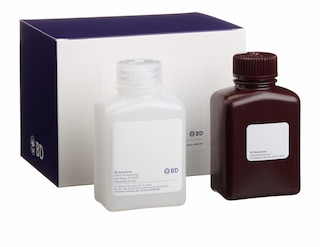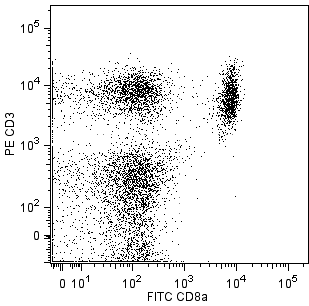-
Your selected country is
Middle East / Africa
- Change country/language
Old Browser
This page has been recently translated and is available in French now.
Looks like you're visiting us from {countryName}.
Would you like to stay on the current country site or be switched to your country?
.png)
.png)
Regulatory Status Legend
Any use of products other than the permitted use without the express written authorization of Becton, Dickinson and Company is strictly prohibited.
Preparation And Storage
Recommended Assay Procedures
It has been observed that pre-incubation of thymus cell suspensions at 37°C for 2 to 4 hours prior to staining enhances the ability of anti-CD3e and anti-TCR β chain mAbs to detect the T cell receptor on immature thymocytes. This antibody conjugate is compatible with intracellular staining protocols using the BD Cytofix/Cytoperm™ Kit (Cat. No. 554714).
Product Notices
- Since applications vary, each investigator should titrate the reagent to obtain optimal results.
- Please refer to www.bdbiosciences.com/us/s/resources for technical protocols.
- Although hamster immunoglobulin isotypes have not been well defined, BD Biosciences Pharmingen has grouped Armenian and Syrian hamster IgG monoclonal antibodies according to their reactivity with a panel of mouse anti-hamster IgG mAbs. A table of the hamster IgG groups, Reactivity of Mouse Anti-Hamster Ig mAbs, may be viewed at http://www.bdbiosciences.com/documents/hamster_chart_11x17.pdf.
- Caution: Sodium azide yields highly toxic hydrazoic acid under acidic conditions. Dilute azide compounds in running water before discarding to avoid accumulation of potentially explosive deposits in plumbing.
Companion Products

.png?imwidth=320)
.png?imwidth=320)

The H57-597 antibody reacts with a common epitope of the β chain of the T-cell Receptor (TCR) complex on αβ TCR-expressing thymocytes, peripheral T lymphocytes, NK1.1+ thymocytes, and NK-T cells of all mouse strains tested. It does not react with γδ TCR-bearing T cells. In the fetal and adult thymus, the TCR β-chain may form homodimers or pair with the pre-TCR α-chain on the surface of immature thymocytes before TCR α-chain expression. Plate-bound or soluble H57-597 antibody activates αβ TCR-bearing T cells, and plate-bound mAb can induce apoptotic death.
This antibody is routinely tested by flow cytometric analysis. Other applications were tested at BD Biosciences Pharmingen during antibody development only or reported in the literature.

Development References (3)
-
Gascoigne NR. Transport and secretion of truncated T cell receptor beta-chain occurs in the absence of association with CD3. J Biol Chem. 1990; 265(16):9296-9301. (Clone-specific: Immunofluorescence, Immunoprecipitation). View Reference
-
Kruisbeek AM, Shevach EM. Proliferative assays for T cell function. Curr Protoc Immunol. 2004; 3:3.12.1-3.12.14. (Clone-specific: Activation, Functional assay, Stimulation). View Reference
-
Kubo RT, Born W, Kappler JW, Marrack P, Pigeon M. Characterization of a monoclonal antibody which detects all murine alpha beta T cell receptors. J Immunol. 1989; 142(8):2736-2742. (Immunogen: Activation, Flow cytometry, Functional assay, Stimulation). View Reference
Please refer to Support Documents for Quality Certificates
Global - Refer to manufacturer's instructions for use and related User Manuals and Technical data sheets before using this products as described
Comparisons, where applicable, are made against older BD Technology, manual methods or are general performance claims. Comparisons are not made against non-BD technologies, unless otherwise noted.
For Research Use Only. Not for use in diagnostic or therapeutic procedures.
Report a Site Issue
This form is intended to help us improve our website experience. For other support, please visit our Contact Us page.